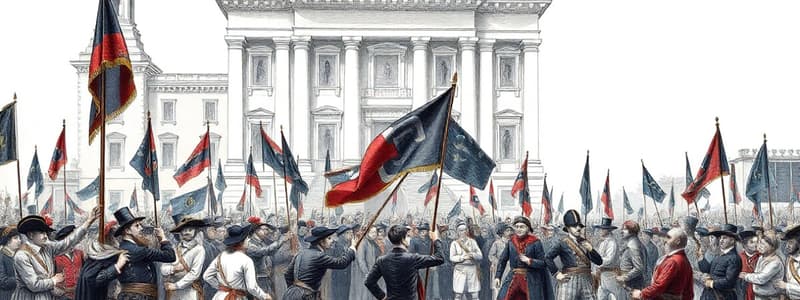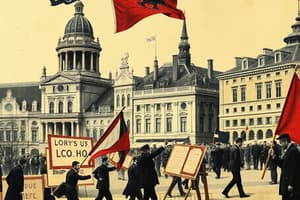Podcast
Questions and Answers
Der König trat zurück, was zur Gründung der ______ führte.
Der König trat zurück, was zur Gründung der ______ führte.
Zweiten Republik
Die Frankfurter Nationalversammlung versuchte, eine ______ für ein vereinigtes Deutschland zu schreiben.
Die Frankfurter Nationalversammlung versuchte, eine ______ für ein vereinigtes Deutschland zu schreiben.
Verfassung
Die nationalistischen Bewegungen in Italien strebten die ______ der italienischen Staaten an.
Die nationalistischen Bewegungen in Italien strebten die ______ der italienischen Staaten an.
Vereinigung
Revolutionäre Gruppen litten häufig unter einem Mangel an ______ und klaren Strategien.
Revolutionäre Gruppen litten häufig unter einem Mangel an ______ und klaren Strategien.
Gegnerische Kräfte unterdrückten die Revolutionen und führten zur Rückkehr zum ______.
Gegnerische Kräfte unterdrückten die Revolutionen und führten zur Rückkehr zum ______.
Die ________ in Europa waren ein bedeutender Faktor für die politischen Veränderungen im 19. Jahrhundert.
Die ________ in Europa waren ein bedeutender Faktor für die politischen Veränderungen im 19. Jahrhundert.
Immer mehr Menschen forderten ______, repräsentative Regierung und individuelle Rechte.
Immer mehr Menschen forderten ______, repräsentative Regierung und individuelle Rechte.
Die sozialen und wirtschaftlichen Probleme waren schwierig schnell zu ______.
Die sozialen und wirtschaftlichen Probleme waren schwierig schnell zu ______.
Die Revolutionen von 1848 waren eine Reihe von republikanischen ______ gegen europäische Monarchien.
Die Revolutionen von 1848 waren eine Reihe von republikanischen ______ gegen europäische Monarchien.
Wirtschaftliche ______ und politische Unzufriedenheit trugen zur Entstehung der Revolutionen bei.
Wirtschaftliche ______ und politische Unzufriedenheit trugen zur Entstehung der Revolutionen bei.
In Frankreich führte die Revolution zur Absetzung von König ______-Philippe und zur Gründung einer Zweiten Republik.
In Frankreich führte die Revolution zur Absetzung von König ______-Philippe und zur Gründung einer Zweiten Republik.
Die Frankfurter Nationalversammlung zielte darauf ab, eine ______ Nation zu schaffen.
Die Frankfurter Nationalversammlung zielte darauf ab, eine ______ Nation zu schaffen.
Die revolutionären Bestrebungen in ______ hatten mit internen Spannungen und Rückschlägen zu kämpfen.
Die revolutionären Bestrebungen in ______ hatten mit internen Spannungen und Rückschlägen zu kämpfen.
In ______ gab es Revolten, die die Herrschaft der Habsburger in Frage stellten.
In ______ gab es Revolten, die die Herrschaft der Habsburger in Frage stellten.
Ein gemeinsames Ziel der Revolutionäre war die Forderung nach größeren ______ Freiheiten.
Ein gemeinsames Ziel der Revolutionäre war die Forderung nach größeren ______ Freiheiten.
Die ______ Ideen und die sozialen Unruhen des 19. Jahrhunderts beeinflussten die Revolutionen.
Die ______ Ideen und die sozialen Unruhen des 19. Jahrhunderts beeinflussten die Revolutionen.
Flashcards
Die Revolutionen von 1848
Die Revolutionen von 1848
Eine Reihe von republikanischen Aufständen gegen europäische Monarchien im Jahr 1848, die größtenteils erfolglos blieben, aber einflussreich waren.
Wirtschaftliche Not
Wirtschaftliche Not
Ein wichtiger Faktor, der zu den Revolutionen von 1848 führte, war die weit verbreitete wirtschaftliche Notlage, die durch Missernten und wirtschaftliche Depressionen verursacht wurde, die zu Armut und Arbeitslosigkeit führten.
Nationalismus
Nationalismus
Der Wunsch nach Selbstbestimmung und nationaler Einheit unter verschiedenen ethnischen Gruppen, insbesondere in Regionen wie Italien und den deutschen Staaten, war eine treibende Kraft hinter den Revolutionen.
Politische Reform
Politische Reform
Signup and view all the flashcards
Soziale und intellektuelle Bewegungen
Soziale und intellektuelle Bewegungen
Signup and view all the flashcards
Langfristige Auswirkungen
Langfristige Auswirkungen
Signup and view all the flashcards
Revolutionen von 1848
Revolutionen von 1848
Signup and view all the flashcards
Deutsche Revolution
Deutsche Revolution
Signup and view all the flashcards
Italienische Revolution
Italienische Revolution
Signup and view all the flashcards
Österreichische Revolution
Österreichische Revolution
Signup and view all the flashcards
Mangel an Einheit
Mangel an Einheit
Signup and view all the flashcards
Konturrevolutionäre Kräfte
Konturrevolutionäre Kräfte
Signup and view all the flashcards
Liberalismus
Liberalismus
Signup and view all the flashcards
Study Notes
Overview of the Revolutions of 1848
- The Revolutions of 1848 were a series of republican uprisings against European monarchies, largely unsuccessful but profoundly influential.
- The revolts spanned across Europe, primarily affecting France, the German states, Italy, and the Austrian Empire.
- Key factors fueling the revolts included economic hardship, discontent with existing political systems, and rising nationalistic aspirations.
- Demands varied regionally, often centering on increased civil liberties, representative government, and national unification.
Contributing Factors
- Economic hardship: Widespread crop failures and economic depression, leading to widespread poverty and unemployment, fueled the revolutionary spirit.
- Nationalism: The desire for self-determination and national unification among diverse ethnic groups – particularly in Italy and the German states – was a significant driving force.
- Political reform: Liberals championed greater civil liberties and representative government, advocating for republicanism or constitutional monarchy as alternatives to monarchical rule.
- Social and Intellectual Movements: The rising influence of liberalism and nationalism, partly fuelled by Enlightenment ideas, social unrest, and evolving philosophies of the time, contributed to the revolutionary atmosphere.
Key Events and Outcomes
- France (February 1848): The overthrow of King Louis-Philippe and the establishment of the Second Republic marked a pivotal moment in the revolutionary wave.
- German states: Upheavals demanded unification and liberal reforms, with the Frankfurt National Assembly prominently seeking to create a unified German nation.
- Italy: Revolutions aimed at unifying Italian states into a single nation, but faced obstacles due to regional divisions and foreign interference, particularly by Austria.
- Austria: Revolts across the empire challenged Habsburg rule, highlighting ethnic tensions and nationalistic aspirations. The ensuing suppression resulted in significant political and economic instability.
- Outcome: While immediate goals were largely unmet, the Revolutions of 1848 constituted a significant turning point in European history, paving the way for future changes.
- Long-term impact: The revolutions played a pivotal role in shaping modern nation-states and strengthening liberal and nationalistic ideals.
Specific Examples of Revolutions
- France: Parisian demonstrations against King Louis-Philippe triggered the revolution. The king's subsequent abdication led to the establishment of the Second Republic in February 1848. However, internal conflicts plagued the newly formed republic.
- German states: A growing desire for political reform and national unification sparked uprisings throughout the German states. The failed Frankfurt National Assembly underscored the obstacles in achieving a unified Germany.
- Italy: Nationalist movements pursued the unification of Italian states, but regional differences and foreign intervention (e.g., Austrian influence) hindered progress.
- Austrian Empire: Revolts arose across different parts of the empire, primarily driven by ethnic tensions and calls for greater autonomy. Nationalist groups, like those in Hungary and Bohemia, actively sought independence.
Factors that led to Failure
- Lack of Unity: Revolutionary groups often lacked strong leadership and overarching strategies, leading to internal divisions and disagreements.
- Counter-revolutionary forces: Existing monarchies and their loyalists actively suppressed rebellions through military force, reasserting the status quo.
- Economic Obstacles: Ongoing economic instability hindered the revolutionary movements, making it challenging to address the root causes and rapid reform.
- Foreign Interference: Foreign intervention, especially in Italy and the German states, often bolstered the position of existing rulers. Austria, in particular, played a crucial role in preventing unification efforts.
- Lack of Lasting Reform: Despite the upheaval, the immediate goals of the revolutions were not fully realized, and the old order's legacy remained.
Intellectual and Ideological Influences
- Liberalism: The drive for expanded civil liberties, representative government, and individual rights powered the revolutions. Liberalist thought concerning individual rights and limitations on state power propelled calls for change.
- Nationalism: Nationalist sentiments were pivotal. The desire for self-determination and unified nation-states significantly shaped the political tensions and popular movements of the era.
- Socialism: Emerging socialist ideas, though not always central, influenced some revolutionary movements. Proposals for social reform and wealth redistribution emerged alongside calls for political advancement.
Legacy
- The Revolutions of 1848 fundamentally reshaped the European political landscape. Although not immediately successful, they laid the groundwork for future social and political reforms.
- Concepts of national unity, representative government, and individual rights endured and influenced the political environment for decades to come.
- The revolutions proved the potency of popular movements in challenging established authorities, though the immediate goals remained unattained.
Studying That Suits You
Use AI to generate personalized quizzes and flashcards to suit your learning preferences.





